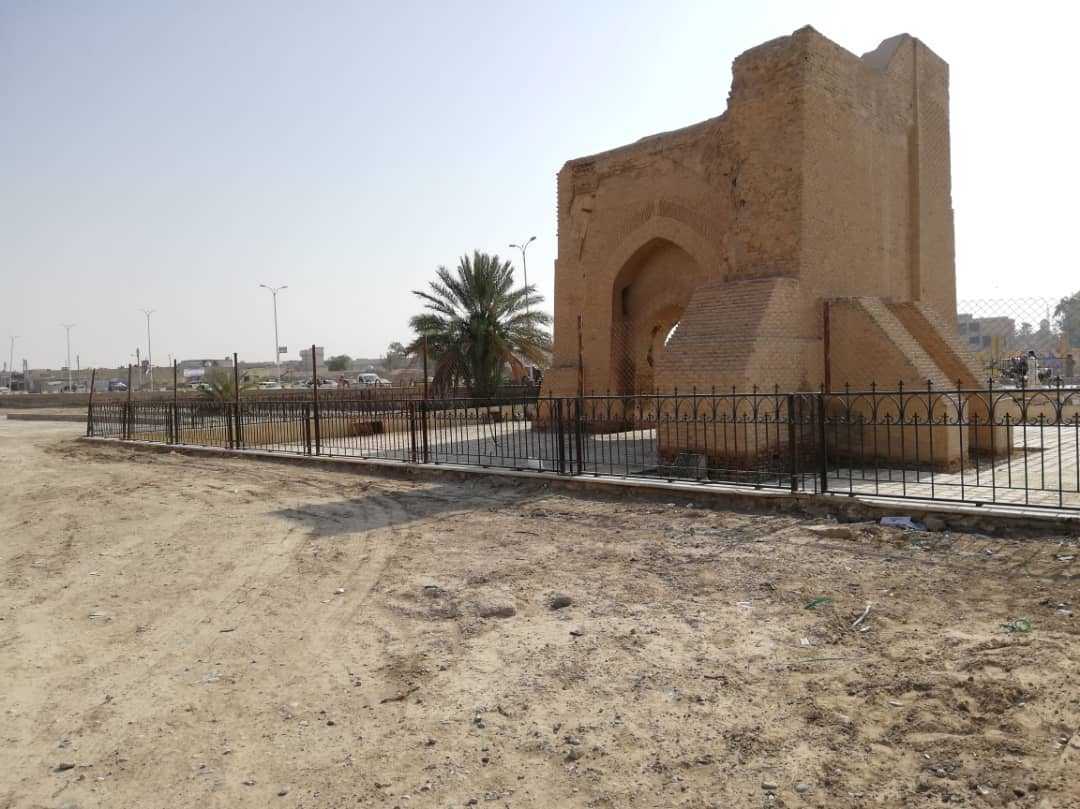In a city buried by rubble, Raqqa residents work to restore ‘life’ to ancient heritage sites
The deadly expulsion of the Islamic State from Syria’s Raqqa last October was, arguably, one of the most destructive events in the ancient city’s 1,500-year history.
8 August 2018
Raqqa’s Abbasid-era Baghdad Gate in July. Photo courtesy of Oxygen Shabab.
AMMAN: The deadly expulsion of the Islamic State from Syria’s Raqqa last October was, arguably, one of the most destructive events in the ancient city’s 1,500-year history.
US-led coalition airstrikes targeting Islamic State (IS) fighters nevertheless leveled at least 11,000 buildings, leaving mountains of rubble that spilled across thoroughfares, stretching for miles across a shattered cityscape.
While the vast majority of the devastation was inflicted on Raqqa’s modern urban fabric, damage to its historic Old City was also significant. Syrian Democratic Forces (SDF) stormed the fabled old quarter in September after coalition aircraft blasted two holes through the Rafiqah Wall, a 2,500-meter barrier built during the Abbasid Caliphate that rings the historic neighborhood. Further bombardments and subsequent clashes also resulted in extensive damage to a number of renowned sites throughout the Old City.
Beyond battlefield damage, IS–reviled for its destruction of cultural artifacts and key heritage sites–had looted the historic Raqqa Museum. Other sights were vandalized and converted into waste dumping grounds, including the 8th-century Baghdad Gate and the medieval Qasr al-Banat, or “Palace of the Ladies.”
But with IS now driven back, a burgeoning group of civil society organizations have sprung up in recent months to address the daunting task of renovating and rebuilding the city’s crumbling heritage sites.
Oxygen Shabab, a grassroots, US-backed organization, is one of several groups engaged in reconstruction efforts in Raqqa’s Old City. While principally focused on the restoration of educational and health services, the group is also at work repairing the Rafiqah Wall.
Bashar al-Naif, a Raqqa resident who has been working in recent weeks with Oxygen Shabab to restore the wall, anticipates the project could last one month. The site, Naif says, has always been a monument vital to the city’s collective memory and identity.
“The wall was a special place, a space for families. It used to have a large garden, too,” he tells Syria Direct.
Founded two months after the expulsion of IS, Vision for Humanitarian Action (VHA) is another grassroots organization dedicated to undoing years of vandalism and neglect toward the city’s historic quarter. The local group has, since early June, primarily focused on restoring the Raqqa Museum, once the site of a medieval palace. Surveyors estimate some 75 percent of the museum has been damaged since war broke out in 2011, one VHA member told Syria Direct, requesting anonymity for security reasons.
At present, around 60 workers are engaged in restoration efforts with VHA. Their work is part of a larger US-funded effort to “stabilize” post-IS Raqqa and restore the city’s crumbling urban infrastructure.
“These monuments are more than just stone,” the VHA member told Syria Direct. “They are the history of Raqqa, the simplicity and beauty of its past. Its present ruin is a challenge, and this reconstruction is [part of] building a new future.”
This series of before-and-after photos from Raqqa, obtained by Syria Direct’s Ammar Hamou, show the ongoing renovation efforts at several sites around Raqqa’s Old City. All photos courtesy of Oxygen Shabab.
The Rafiqah Wall, which encircles the Old City, was heavily damaged during clashes between IS fighters and international coalition forces.
The Baghdad Gate, transformed into a waste dumping site during the years of IS rule, is currently being renovated by local civil society groups.
“These monuments are more than just stone,” says one NGO worker helping the restoration effort. “They are the history of Raqqa, the simplicity and beauty of its past. Its present ruin is a challenge, and this reconstruction is [part of] building a new future.”
“IS gave the idea to the world that this city is a city of terror. In fact, the city of Raqqa, like all the cities of the world, has a life, a civilization and a heritage.”
With reporting by Abdullah Ismail.
This photo essay is part of Syria’s month-long coverage of former Islamic State-held territories in partnership with the Konrad Adenauer Foundation and reporters on the ground in Syria. Read our primer here.













